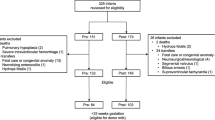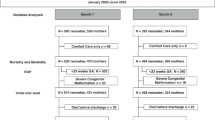Abstract
Background
Donor breast milk (DBM) feeding has been associated with less growth than formula in preterm infants. Zinc content in DBM is insufficient to support growth in preterm infants.
Objective
To compare growth from birth to discharge, macro- and micronutrient intake and the frequency of poor growth before (Epoch-1) and after (Epoch-2) implementing a DBM program.
Methods
Retrospective cohort study of 1069 infants born at < 33 weeks’ gestational age or birthweight < 1500 g and fed using our adjustable feeding protocol with accurate serial length measurements. Growth was assessed by changes in Z-scores of weight, length and fronto-occipital circumference from birth to discharge.
Results
Growth did not decrease significantly in Epoch-2. However, energy and protein intake increased by 5% and frequency of zinc and vitamin D supplementation increased by >30%.
Conclusions
DBM implementation did not significantly decrease growth from birth to discharge using our adjustable feeding protocol.
This is a preview of subscription content, access via your institution
Access options
Subscribe to this journal
Receive 12 print issues and online access
$259.00 per year
only $21.58 per issue
Buy this article
- Purchase on SpringerLink
- Instant access to full article PDF
Prices may be subject to local taxes which are calculated during checkout
Similar content being viewed by others
Data availability
The datasets generated and/or analyzed during the current study are available from the corresponding author on reasonable request.
References
Breastfeeding SO, Eidelman AI, Schanler RJ, Johnston M, Landers S, Noble L, et al. Breastfeeding and the Use of Human Milk. Pediatrics 2012;129:e827–e41.
Boquien CY. Human milk: An ideal food for nutrition of preterm newborn. Front Pediatr. 2018;6:295.
Lapidaire W, Lucas A, Clayden JD, Clark C, Fewtrell MS. Human milk feeding and cognitive outcome in preterm infants: the role of infection and NEC reduction. Pediatr Res. 2022;91:1207–14.
Brown JVE, Walsh V, McGuire W. Formula versus maternal breast milk for feeding preterm or low birth weight infants. Cochrane Database Syst Rev. 2019;8:Cd002972.
Strobel NA, Adams C, McAullay DR, Edmond KM. Mother’s own milk compared with formula milk for feeding preterm or low birth weight infants: systematic review and meta-analysis. Pediatrics 2022;150:e2022057092D.
Taylor SN, Fenton TR, Groh-Wargo S, Gura K, Martin CR, Griffin IJ, et al. Exclusive maternal milk compared with exclusive formula on growth and health outcomes in very-low-birthweight preterm infants: Phase II of the Pre-B project and an evidence analysis center systematic review. Front Pediatr. 2021;9:793311.
Miller J, Tonkin E, Damarell RA, McPhee AJ, Suganuma M, Suganuma H, et al. A systematic review and meta-analysis of human milk feeding and morbidity in very low birth weight infants. Nutrients 2018;10:707.
Peng W, Han J, Li S, Zhang L, Yang C, Guo J, et al. The association of human milk feeding with short-term health outcomes among chinese very/extremely low birth weight infants. J Hum Lact. 2022;38:670–7.
Underwood MA. Human milk for the premature infant. Pediatr Clin North Am. 2013;60:189–207.
Boundy EO, Anstey EH, Nelson JM. Donor human milk use in advanced neonatal care units - United States, 2020. MMWR Morb Mortal Wkly Rep. 2022;71:1037–41.
Nutrition CO, Breastfeeding SO, Fetus CO, Newborn, daniels S, Corkins M, et al. Donor human milk for the high-risk infant: Preparation, safety, and usage options in the United States. Pediatrics 2017;139:e20163440.
Quigley M, Embleton ND, McGuire W. Formula versus donor breast milk for feeding preterm or low birth weight infants. Cochrane Database Syst Rev. 2018;6:Cd002971.
Madore LS, Bora S, Erdei C, Jumani T, Dengos AR, Sen S. Effects of donor breastmilk feeding on growth and early neurodevelopmental outcomes in preterm infants: An observational study. Clin Ther. 2017;39:1210–20.
Montjaux-Régis N, Cristini C, Arnaud C, Glorieux I, Vanpee M, Casper C. Improved growth of preterm infants receiving mother’s own raw milk compared with pasteurized donor milk. Acta Paediatr. 2011;100:1548–54.
Parker LA, Cacho N, Engelmann C, Benedict J, Wymer S, Michael W, et al. Consumption of mother’s own milk by infants born extremely preterm following implementation of a donor human milk program: A retrospective cohort study. J Pediatr. 2019;211:33–8.
Fu TT, Schroder PE, Poindexter BB. Macronutrient analysis of target-pooled donor breast milk and corresponding growth in very low birth weight infants. Nutrients 2019;11:1884.
Gidrewicz DA, Fenton TR. A systematic review and meta-analysis of the nutrient content of preterm and term breast milk. BMC Pediatr. 2014;14:216.
Fu TT, Kaplan HC, Fields T, Folger AT, Gordon K, Poindexter BB. Protein enrichment of donor breast milk and impact on growth in very low birth weight infants. Nutrients 2021;13:2869.
Agostoni C, Buonocore G, Carnielli V, De Curtis M, Darmaun D, Decsi T, et al. Enteral nutrient supply for preterm infants: Commentary from the European society of paediatric gastroenterology, hepatology and nutrition committee on nutrition. J Pediatr Gastroenterol Nutr. 2010;50:85–91.
Gates A, Marin T, Leo G, Stansfield BK. Review of preterm human-milk nutrient composition. Nutr Clin Pr. 2021;36:1163–72.
Young BE, Borman LL, Heinrich R, Long J, Pinney S, Westcott J, et al. Effect of pooling practices and time postpartum of milk donations on the energy, macronutrient, and zinc concentrations of resultant donor human milk pools. J Pediatr. 2019;214:54–9.
Alshaikh B, Abo Zeed M, Yusuf K, Guin M, Fenton T. Effect of enteral zinc supplementation on growth and neurodevelopment of preterm infants: A systematic review and meta-analysis. J Perinatol. 2022;42:430–9.
Brion LP, Heyne R, Lair CS. Role of zinc in neonatal growth and brain growth: Review and scoping review. Pediatr Res. 2021;89:1627–40.
Staub E, Evers K, Askie LM. Enteral zinc supplementation for prevention of morbidity and mortality in preterm neonates. Cochrane Database Syst Rev. 2021;3:Cd012797.
Gomes FP, Shaw PN, Whitfield K, Koorts P, McConachy H, Hewavitharana AK. Effect of pasteurisation on the concentrations of vitamin D compounds in donor breastmilk. Int J Food Sci Nutr. 2016;67:16–9.
Gates A, Marin T, De Leo G, Waller JL, Stansfield BK. Nutrient composition of preterm mother’s milk and factors that influence nutrient content. Am J Clin Nutr. 2021;114:1719–28.
við Streym S, Højskov CS, Møller UK, Heickendorff L, Vestergaard P, Mosekilde L, et al. Vitamin D content in human breast milk: a 9-mo follow-up study. Am J Clin Nutr. 2016;103:107–14.
Casey CF, Slawson DC, Neal LR. Vitamin D supplementation in infants, children, and adolescents. Am Fam Physician. 2010;81:745–8.
Yang Y, Li Z, Yan G, Jie Q, Rui C. Effect of different doses of vitamin D supplementation on preterm infants - an updated meta-analysis. J Matern Fetal Neonatal Med. 2018;31:3065–74.
Ma K, Wei SQ, Bi WG, Weiler HA, Wen SW. Effect of Vitamin D supplementation in early life on children’s growth and body composition: A systematic review and meta-analysis of randomized controlled trials. Nutrients 2021;13:524.
Mølgaard C, Michaelsen KF. Vitamin D and bone health in early life. Proc Nutr Soc. 2003;62:823–8.
Pavageau L, Rosenfeld CR, Heyne R, Brown LS, Whitham J, Lair C, et al. Valid serial length measurements in preterm infants permit characterization of growth patterns. J Perinatol. 2018;38:1694–701.
Brion LP, Rosenfeld CR, Heyne R, Brown SL, Lair CS, Burchfield PJ, et al. Adjustable feedings plus accurate serial length measurements decrease discharge weight-length disproportion in very preterm infants: quality improvement project. J Perinatol. 2019;39:1131–9.
Mandiá N, Bermejo-Barrera P, Herbello P, López-Suárez O, Fraga JM, Fernández-Pérez C, et al. Human milk concentrations of minerals, essential and toxic trace elements and association with selective medical, social, demographic and environmental factors. Nutrients. 2021;13:1885.
Domellöf M. Nutritional care of premature infants: Microminerals. World Rev Nutr Diet. 2014;110:121–39.
Sanchez AM, Mize SG, Jimenez JM, Manroe BL, Rosenfeld CR, Tyson TE. Systems approach to the evaluation of maternal and neonatal care. Proc 12th Hawaii Int’l Conf Syst Sci, Sel Pap Med Inf Process. 1979;III:140–51.
Kaiser JR, Tilford JM, Simpson PM, Salhab WA, Rosenfeld CR. Hospital survival of very-low-birth-weight neonates from 1977 to 2000. J Perinatol. 2004;24:343–50.
Kliegman, RM, Walsh, MC. Neonatal necrotizing enterocolitis: Pathogenesis classification and spectrum of illness. Current Problems in Pediatrics. 1987;17:219–88. https://doi.org/10.1016/0045-9380(87)90031-4.
John A, Sun R, Maillart L, Schaefer A, Hamilton Spence E, Perrin MT. Macronutrient variability in human milk from donors to a milk bank: Implications for feeding preterm infants. PLoS One. 2019;14:e0210610.
Rochow N, Raja P, Liu K, Fenton T, Landau-Crangle E, Göttler S, et al. Physiological adjustment to postnatal growth trajectories in healthy preterm infants. Pediatr Res. 2016;79:870–9.
Brion LP, Heyne R, Brown LS, Lair CS, Edwards A, Burchfield PJ, et al. Zinc deficiency limiting head growth to discharge in extremely low gestational age infants with insufficient linear growth: a cohort study. J Perinatol. 2020;40:1694–704.
O’Connor DL, Gibbins S, Kiss A, Bando N, Brennan-Donnan J, Ng E, et al. GTA DoMINO feeding group. Effect of supplemental donor human milk compared with preterm formula on neurodevelopment of very low-birth-weight infants at 18 months: A randomized clinical trial. JAMA 2016;316:1897–905.
Boscarino G, Gasparini C, Conti MG, Di Chiara M, Terrin G. Zinc levels in neonatal life influence long-term neurodevelopment. J Perinatol. 2021;41:1196–7.
Kim SY, Park JH, Kim EA, Lee-Kim YC. Longitudinal study on trace mineral compositions (selenium, zinc, copper, manganese) in Korean human preterm milk. J Korean Med Sci. 2012;27:532–6.
Casey CE, Neville MC, Hambidge KM. Studies in human lactation: Secretion of zinc, copper, and manganese in human milk. Am J Clin Nutr. 1989;49:773–85.
Acknowledgements
This study was funded by the Children’s Medical Center Clinical Advisory Committee (CCRAC) (LP Brion) and by the Department of Pediatrics at UT Southwestern Medical Center.
Author contributors
MSR conceptualized and designed the study, collected and reviewed data from the medical records and wrote the first draft of the manuscript. CL, AE, and TJ collected and reviewed data from the medical records, participated in the interpretation of the data. LPB conceptualized and designed the study, collected and reviewed data from the medical records. LPB and LSB conducted statistical analyses. PJB, PS, IK, DV, and CC, IT specialist at Parkland Hospital, extracted data from the electronic health record. All authors participated in the interpretation of the data, critically reviewed the revisions, and approved the final manuscript as submitted. We thank Mambarambath Jaleel, MD and Elen Petrosyan, RD, who were instrumental in implementing the DBM program. Aktar Ali, MS performed DBM sample analysis for copper and zinc in Dr. Orson Moe’s laboratory at UT Southwestern Medical Center. Anita Thomas, RN, helped with data collection into the resuscitation database.
Author information
Authors and Affiliations
Corresponding author
Ethics declarations
Competing interests
The authors declare no competing interests.
Additional information
Publisher’s note Springer Nature remains neutral with regard to jurisdictional claims in published maps and institutional affiliations.
Supplementary information
Rights and permissions
Springer Nature or its licensor (e.g. a society or other partner) holds exclusive rights to this article under a publishing agreement with the author(s) or other rightsholder(s); author self-archiving of the accepted manuscript version of this article is solely governed by the terms of such publishing agreement and applicable law.
About this article
Cite this article
Sanchez-Rosado, M., Lair, C.S., Edwards, A. et al. Growth after implementing a donor breast milk program in neonates <33 weeks gestational age or birthweight <1500 grams: Retrospective cohort study. J Perinatol 43, 608–615 (2023). https://doi.org/10.1038/s41372-023-01627-2
Received:
Revised:
Accepted:
Published:
Issue date:
DOI: https://doi.org/10.1038/s41372-023-01627-2
This article is cited by
-
Improved linear growth after routine zinc supplementation in preterm very low birth weight infants
Pediatric Research (2025)
-
Early human milk feeding: Relationship to intestinal barrier maturation and postnatal growth
Pediatric Research (2024)
-
A validated NICU database: recounting 50 years of clinical growth, quality improvement and research
Pediatric Research (2024)



